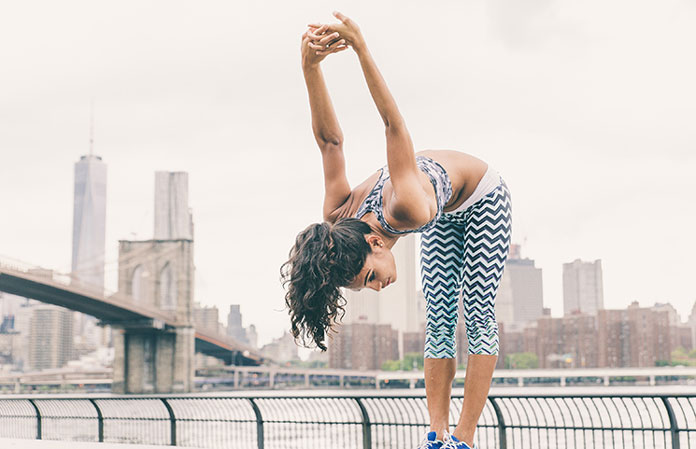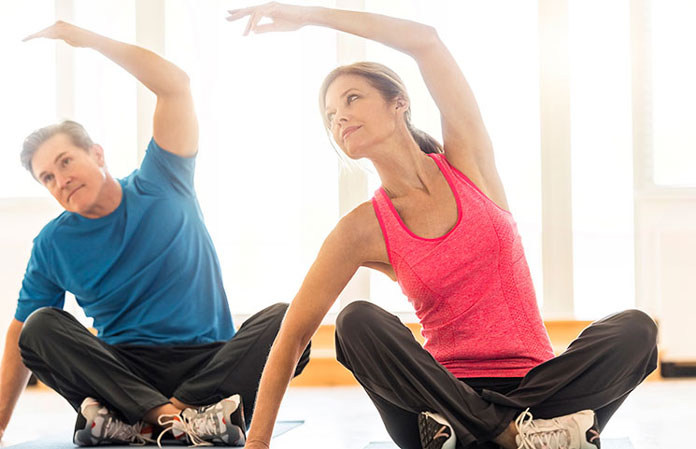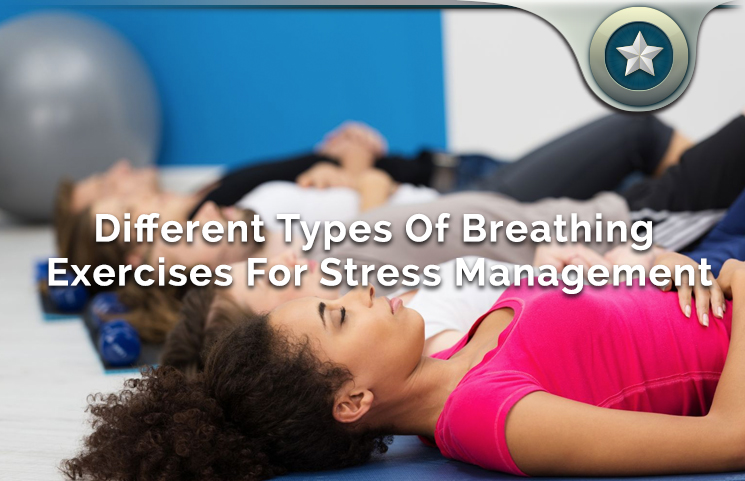Proper breathing enables the body to acquire sufficient oxygen with minimum effort. Stress Management Breathing Exercises allow relaxation of the mind, soul, and body when you're under stress. Performing some simple breathing techniques can help alleviate stress and anxiety.
The best thing about breathing exercises is that they can be done anywhere. They are best done in a quiet and peaceful environment where one can sit with their spine straight, but they can also help you get through stressful situations in any environment.
The eyes and the chin should be level with the horizon position. For optimal results, you should practice when you're already relaxed and wearing loose clothing.
Why Stress Management Breathing Exercises?
Healthy lungs make breathing an easy and natural task. The diaphragm performs more than 80 percent of the work to fill the lungs with oxygen and remove waste gasses.
The waste gas is likely to build up, leaving less room for the diaphragm to contract and allow oxygen to enter. When the diaphragm is not working properly, the body is forced to utilize other muscles found in the neck, chest, and back to perform the breathing task.
As a result, there will be insufficient oxygen levels in the body, and the air available for exercise and activity will be less. A regular performance of the stress management breathing exercises can help remove the accumulated stale air in the lungs to create room for fresh oxygen air. Breathing exercises will also promote the performance of the diaphragm.

Benefits Of Stress Management Breathing Exercises
Manage Chronic Obstructive Pulmonary Disease (COPD)
Individuals who have been diagnosed with COPD could benefit from performing regular breathing exercises. One of the most common symptoms of COPD involves difficulty in breathing. Some people confuse the symptoms with aging.
As the disorder progresses, the compromised diaphragm fails to bring in fresh oxygen. The body begins to use other muscles located in the neck, chest, and the back to assist in the breathing process. As a result, patients start to present with symptoms such as fatigue, weakness, and paleness due to lack of adequate oxygen in the body.
Individuals with COPD will often find themselves tired and gasping for air upon performing simple activities, such as climbing the stairs. The COPD Foundation released a report showing that over 30 million Americans suffer from COPD each year.
However, studies have revealed that performing regular breathing exercises can help improve the symptoms that are associated with the respiratory disorder.
Breathing exercises and techniques are necessary when other intensive pulmonary care is not sufficient. One study concluded that performing breathing exercises could help improve the quality of life as well as the ability of the lungs to take in more oxygen.
Breathing exercises provide a cheaper alternative compared to the expensive medications and rehab programs that are commonly utilized for COPD patients. According to the researchers, breathing exercises are an economical remedy that can be utilized to improve the physical capacity and the general quality of life of COPD patients.
Improve Sleep And Manage Stress
Breathing exercises have been shown to also improve the sleeping pattern of an individual. There are specific types of breathing techniques that can be used to help with downregulation of the sympathetic system and stimulate the parasympathetic system.
The sympathetic system is responsible for the body's fight or flight response, while the parasympathetic system controls the ability of the body to relax. One can help the body to relax by performing deep breathing exercises while in bed.
Paying full attention to the breathing pattern makes the mind focus on the task at hand and not on the thoughts that might occupy the person's mind, which helps the person to become deeply relaxed sooner.
Breathing techniques can also help manage stress. They help activate the parasympathetic nervous system, which allows the body to relax and stop worrying. When a person is stressed, the sympathetic nervous system is activated, putting the body on the fight or flight mode.
However, breathing exercises can help redirect the body away from the fight or flight mode to a relaxed mood. As a result, the person will experience a sense of relaxation, a slower heart rhythm, and deeper breathing.
Help Lower Blood Pressure
Regular breathing exercises are especially helpful to individuals who have been diagnosed with hypertension. The American Heart Association included breathing exercises in their 2013 recommendation as an effective alternative to controlling blood pressure.
A study was recently performed in Japan with an objective of finding out the impact of breathing exercises on patients with high blood pressure.
The study discovered that breathing exercises are beneficial to individuals who have high blood pressure. The study found that the participants had a lower blood pressure after conducting six rounds of deep breathing exercises for a 30 second interval.
Lower Anxiety
Breathing exercises are recommended as the best way to help troubled individuals to relax. A study was performed to find the impact of breathing exercise on musicians before doing a live performance to a broad audience.
The musicians performed breathing exercises 30 minutes before performing for their fans. The study found out that breathing exercises helped lower their heart rates and helped them feel less anxious.
According to the scientists, the results of the study were impressive. They concluded that one session of slower breathing could help reduce anxiety. Another study suggested that breathing exercises can help to reduce the stress that is associated with Chronic Obstructive Pulmonary Disorder (COPD).
The study was performed on 46 participants that had been diagnosed with the respiratory disease. The study discovered that regular performance of breathing techniques could help improve symptoms that are associated with COPD, such as shortness of breath and exercise intolerance.

Stress Management Breathing Exercises And Techniques
There are several types of breathing exercises that one can use to relax. Most of the breathing exercises are simple to learn and easy to perform. One does not need to have a specialist to take them through the whole exercise. One of the most natural breathing exercises is called belly breathing.
According to WebMD, all beginners should consider beginning with belly breathing before proceeding to the more advanced breathing exercises.
Belly Breathing
Belly breathing is a simple exercise, and it is relaxing. It can be performed anytime one needs to relax or get rid of stress. Belly breathing can be carried out by sitting or lying flat in a comfortable position.
One hand should be placed on the belly just below the ribs, and the other hand should be put on the chest.
The person should then take a deep breath through the nose while allowing the belly to push their hand towards the outward direction. One should then breathe out through pursed lips as if they were whistling.
The hand on the belly should be used to push all the air present in the lungs out. The breathing process should be performed three to ten times. After performing belly breathing successfully, one can consider performing the more advanced breathing exercises.
Diaphragmatic Breathing
The diaphragm is an active muscle of respiration. The abdominal muscles move the diaphragm, enabling the lungs to expel stale air and take in fresh oxygen. Certain respiratory disorders, such as COPD, may interfere with the normal performance of the diaphragm.
When an individual is diagnosed with a pulmonary disease, the air that is trapped in the lungs can push down on the diaphragm. The muscle is left weakened and performing its work inefficiently. Diaphragmatic breathing aims at strengthening the diaphragm and decreasing the demand for oxygen in the body.
The breathing exercise also helps to reduce the breathing rate, so your body is not working as hard to breathe. Diaphragmatic breathing involves lying down on one's back on a flat surface or bed. The knees should be bent, and the head supported. A pillow can be put under the knees to support the legs.
One hand should be placed on the upper chest and the other hand just below the rib cage. The positioning of the hands will allow the person to feel the diaphragm move as they breathe.
As the person lies down, they should breathe slowly through the nose. The stomach should be allowed to move outwards against the hand on the rib cage as the one on the chest remains stable.
The next step involves tightening the stomach muscles enabling them to fall inwards as one breathes out through pursed lips. The hand positioned on the upper chest should remain still.
Diaphragmatic breathing can also be performed while sitting on a chair. The person should sit comfortably while with knees bent and the shoulders, knees, and neck relaxed. The person should then breathe in slowly through the nose allowing the stomach to move against the hand. The hand that is positioned on the chest should remain still.
The diaphragmatic breathing exercise should be practiced three to four times per day for ten minutes each time. The amount of time spent performing the breathing exercise should be gradually increased. One can also increase the effort spent while performing the exercise by placing an item, such as a book, on the abdomen.
The 4-7-8 Breathing Exercise
The 4-7-8 exercise, also known as relaxing breath, is a simple breathing exercise that does not require much time. It can be performed anywhere, and it requires no equipment. The task can be carried out at any position. However, the best position to perform the 4-7-8 breathing exercise involves sitting with the back kept in a straight position.
The tip of the tongue should be placed against the ridge of tissue found behind the upper front teeth. The tip of the tongue should be maintained in this position though the whole exercise. The person will be required to exhale through the mouth around the tongue.
The person should exhale completely through the mouth, producing a whoosh sound. The mouth should be closed and inhalation done quietly through the nose to a count of four. The breath should then be held to a count of seven. The next step involves exhaling completely through the mouth, producing a whoosh sound to the count of eight. The cycle should be repeated three more times for a total of four breaths.
The 4-7-8 breathing exercise involves inhaling quietly through the nose and exhaling audibly through the mouth. The time taken to exhale is twice that taken to inhale. However, the absolute time spent on inhalation and exhalation is not relevant.
The ratio of 4-7-8 is the most important. If holding the breath is difficult, one can speed the exercise while keeping to the ratio 4-7-8 throughout the three phases. The 4-7-8 breathing exercise has been found to be a tranquilizer of the nervous system. The exercise should be performed at least twice a day to achieve maximum benefits.
However, it cannot frequently be performed. One should not perform more than four breaths at one time during the first month of practice. However, they can choose to extend to eight breaths later if they wish.
Breath Counting
Breath counting is a useful technique that can be used to prevent the mind from wandering too far. Breath counting can be performed while seated in a comfortable position with the spine kept in a straight position.
The head should be inclined slightly forward. The individual should then close their eyes while taking a few deep breaths. The breathing process should be allowed to come naturally without trying to force it. The breathing process will be quiet and slow. However, the depth and rhythm should vary.
When the breathing exercise is commenced, one should count “one” as they exhale. During the second exhalation, the person should count “two” and so on up to five. The pattern should be repeated.
One should not count past five. If they discover they have lost the count, it is advisable to start over again.
Yoga Breathing
A controlled breathing pattern forms an important component of a yoga practice. The most common yoga breathing technique is the nostril breathing. It is also practiced by individuals who are interested in keeping their mind from wandering around when they are trying to catch sleep.
To practice nostril breathing, the thumb should be placed over the right nostril as one inhales through the left nostril. Then the right ring finger should be put over the left nostril as one exhales through the right nostril.
The ring finger should be left on the left nostril as the person inhales through the left nostril. Exhalation follows through the left nostril with the thumb placed over the right nostril.

Stress Management Breathing Exercises Review Summary
According to experts, breathing exercises enable individuals to breathe in and out efficiently using the diaphragm.
Changing breathing patterns help people to control their emotions. Breathing exercises can also help ease symptoms such as anxiety, sleep disorder, and COPD. Several breathing exercises can be done to help the body relax.
Belly breathing is the easiest, and once it is mastered, one can progress to the more advanced exercises.









